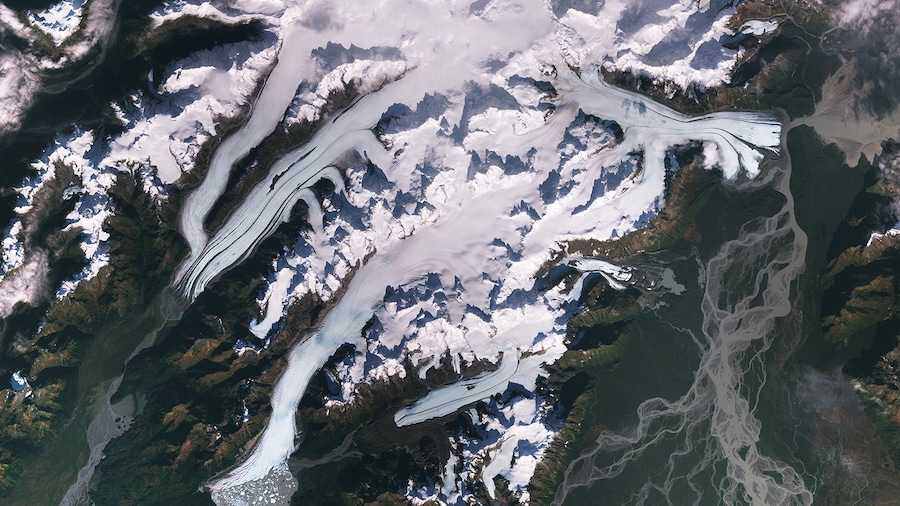This post was originally published on Eco Watch
Accelerating glacial melting is causing the world’s oceans to rise year after year and is causing a loss of regional freshwater, new research led by scientists at the University of Zürich shows.
The world’s glaciers have been losing 273 billion tonnes of ice mass annually, causing oceans to rise by nearly a millimeter per year, which has been accelerating in recent years, the study finds.
“To put this in perspective, the 273 billion tonnes of ice lost in one single year amounts to what the entire global population consumes in 30 years, assuming three litres per person and day,” lead author Michael Zemp said in a press release.
The researchers also found that the rate at which glaciers are melting is accelerating fairly rapidly. The second half of the period studied (from 2012 to 2023) saw a 36% increase in ice loss compared to the first half.
“For some regions, we’re finding a profound change in how quickly that sea ice is disappearing,” Brian Menounos, one of the study authors, a geography professor at the University of Northern British Columbia whose work focuses on the impacts of climate change in western Canada, told EcoWatch on a video call. “In the lower 48 and western Canada,” he added, “we’ve lost something like 23% of the (glacier) volume since 2000,” he said.
The research was a collaborative effort under the World Glacier Monitoring Service and led by researchers at the University of Zürich. The researchers used the Glacier Mass Balance Intercomparison Exercise (GlaMBIE) to collect and analyze huge amounts of data from multiple sources to determine the rate of glacial melting and sea level rise since 2000.
The scientists used several methods to measure glacial ice loss, from the traditional method of manually comparing the amount of snow that accumulates on top of a glacier against the amount of water melting off of it, to much more advanced methods using satellites.
Tyler Sutterley, one of the study authors and senior research scientist at the Applied Physics Lab at the University of Washington, explained over email that one method the researchers used was photogrammetry, where they created 3D models of the glaciers over time from repeated satellite photos in a process called photogrammetry.
The researchers also used radar and laser ranging instruments from NASA’s Ice, Cloud and Land Elevation Satellites (ICESat and ICESat-2) and the European Space Agency’s CryoSat-2 missions to “measure changes in surface topography,” in a process called altimetry, Sutterley wrote, the measurements from which were “combined with estimates of the snow density change to estimate the glacier’s total mass change.”
Glaciers in the Chugach Mountains of Alaska: This image, recorded by the Sentinel-2 satellite on 6 Oct. 6, 2017 shows the melting Scott (left), Sheridan (middle), and Childs (right) glaciers feeding lakes and rivers in their forefields. Copernicus Sentinel data 2017
The last technique the researchers used involved measuring changes in Earth’s gravitational field using data from NASA’s Gravity Recovery and Climate Experiment (GRACE) and its successor, GRACE-FO, which allowed for the researchers to estimate glacial mass changes over wide areas.
Using each of these methods, the researchers created the “most comprehensive assessment of glacier change to date,” Sutterley wrote.
While the research didn’t delve into the causes behind ice loss, the biggest factors are almost certainly continued greenhouse gas emissions, along with a loss of ice and snow that reflects heat outward to space. With both of these factors increasing, we can expect both glacial melting and sea level rise to continue accelerating, Sutterley told EcoWatch on a video call.
“The Earth is tricky, but with our mountain glaciers, I think overall, they are expected to continue to shrink — in some regions, yes, shrink faster and faster — but overall, the going trend is that we are losing our glaciated regions, and it is happening faster and faster,” he said.
A 2021 study found that over 400 million people globally are vulnerable to sea level rise as sea level encroaches on the world’s coasts.
“Sea level rise affects all of us,” Sutterley said. “Most of the world’s population lives near water, whether it’s rivers or coasts, and so starting to lose coastline, as it moves further inland based on sea level rise, is going to affect a lot of people.”
“There’s regions in the South Pacific that live on low-lying islands, and it’s going to take a massive humanitarian effort to deal with what is going to be a humanitarian crisis as we start losing places that are habitable just due to sea level rise,” he said.
“Glaciers are one of the key metrics of climate change,” Sutterley said. “If you look at the big picture, you zoom out and you look at the tens of thousands of glaciers altogether, there you get a picture that is related to the energy balance of the planet, and where this energy is going. It’s going into the ocean. It’s melting ice, it’s heating our soils. And so having this broad view gives you this look on where this is going [and] what’s the cost.”
“We will directly notice the melting of these glaciers. Because they are located where many people live, it will affect drinking water supplies, in particular in South America and Asia. And the risk of flooding after the melt season also poses a danger,” Bert Wouters, one of the researchers and associate professor of geoscience and remote sensing at Delft University of Technology, wrote in a press release.
Menounos said that the research will likely continue in the future with a successor to the GLaMBIE project.
“The next steps are for the collaborators of GlaMBIE, 1.0, if you want to call it that, to reach out to the community and propose a follow-up study. And that will take several years for people to get together, to meet at conferences, have workshops, and really sort of dive into perhaps things or aspects that we didn’t have time or we didn’t have data to look at specific regions or look at try to reduce biases in some regions.”
The post Glacial Melting Is Accelerating, Driving Sea Level Rise and Depleting Freshwater: Study appeared first on EcoWatch.





0 Comments